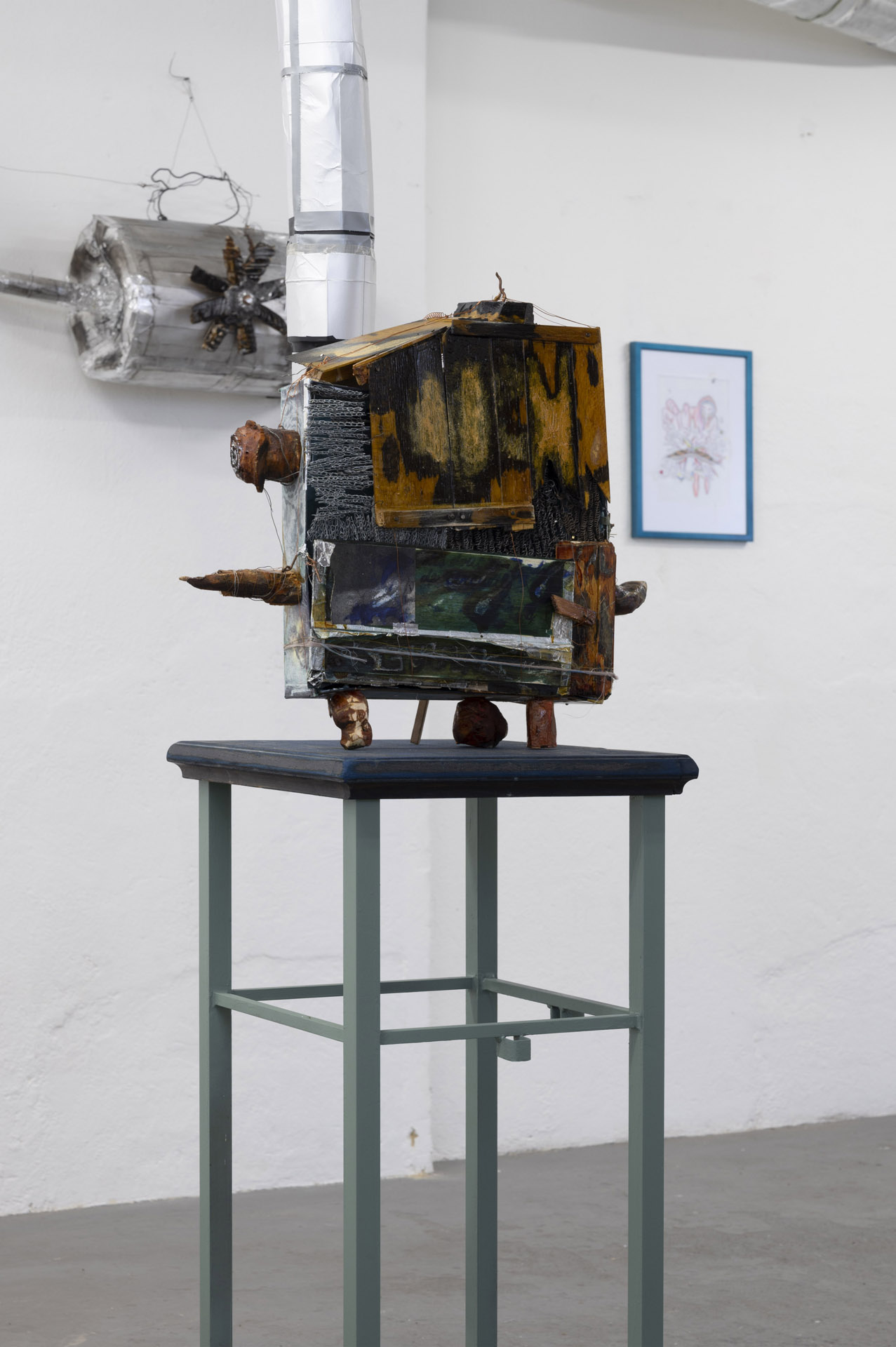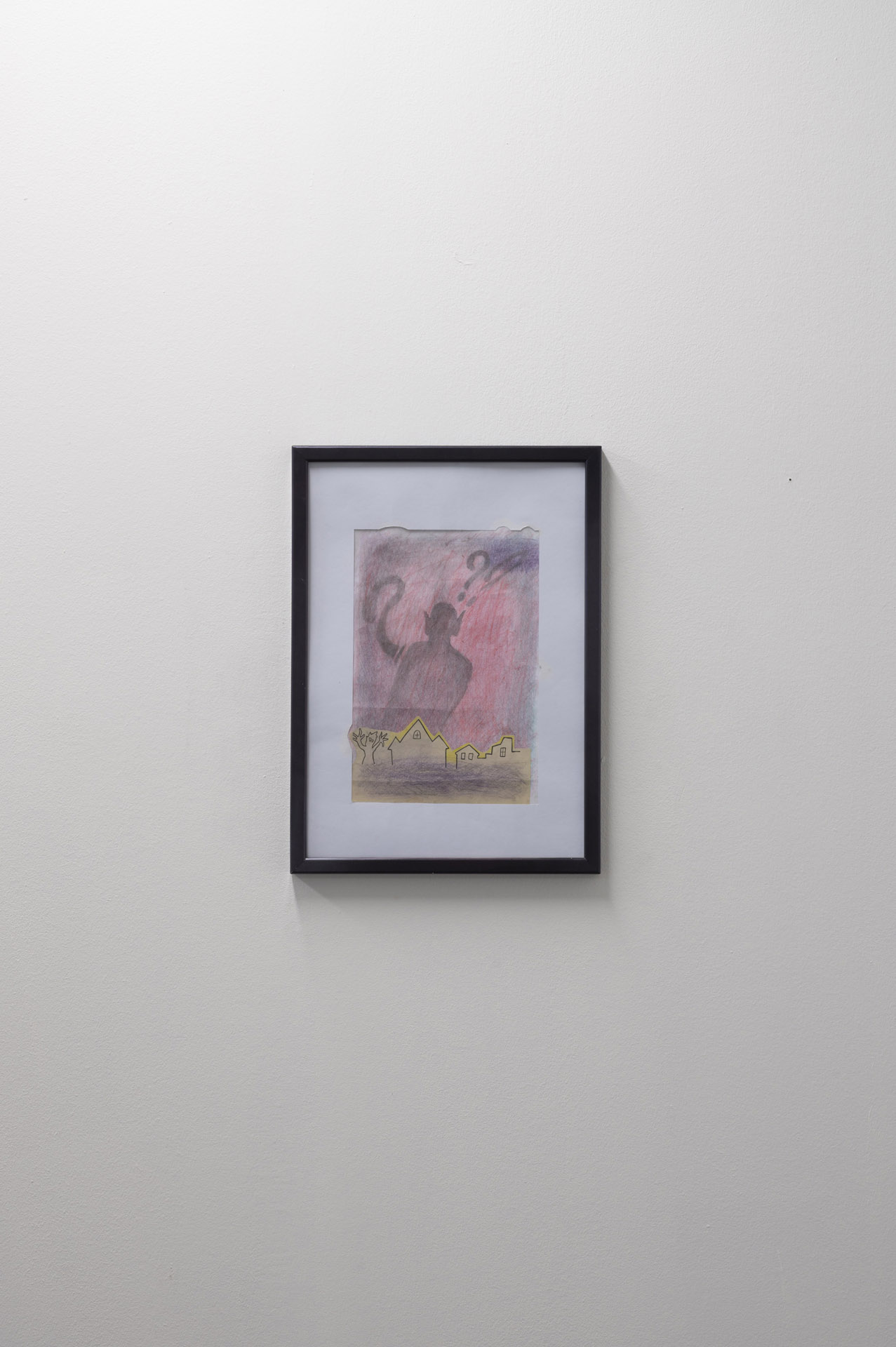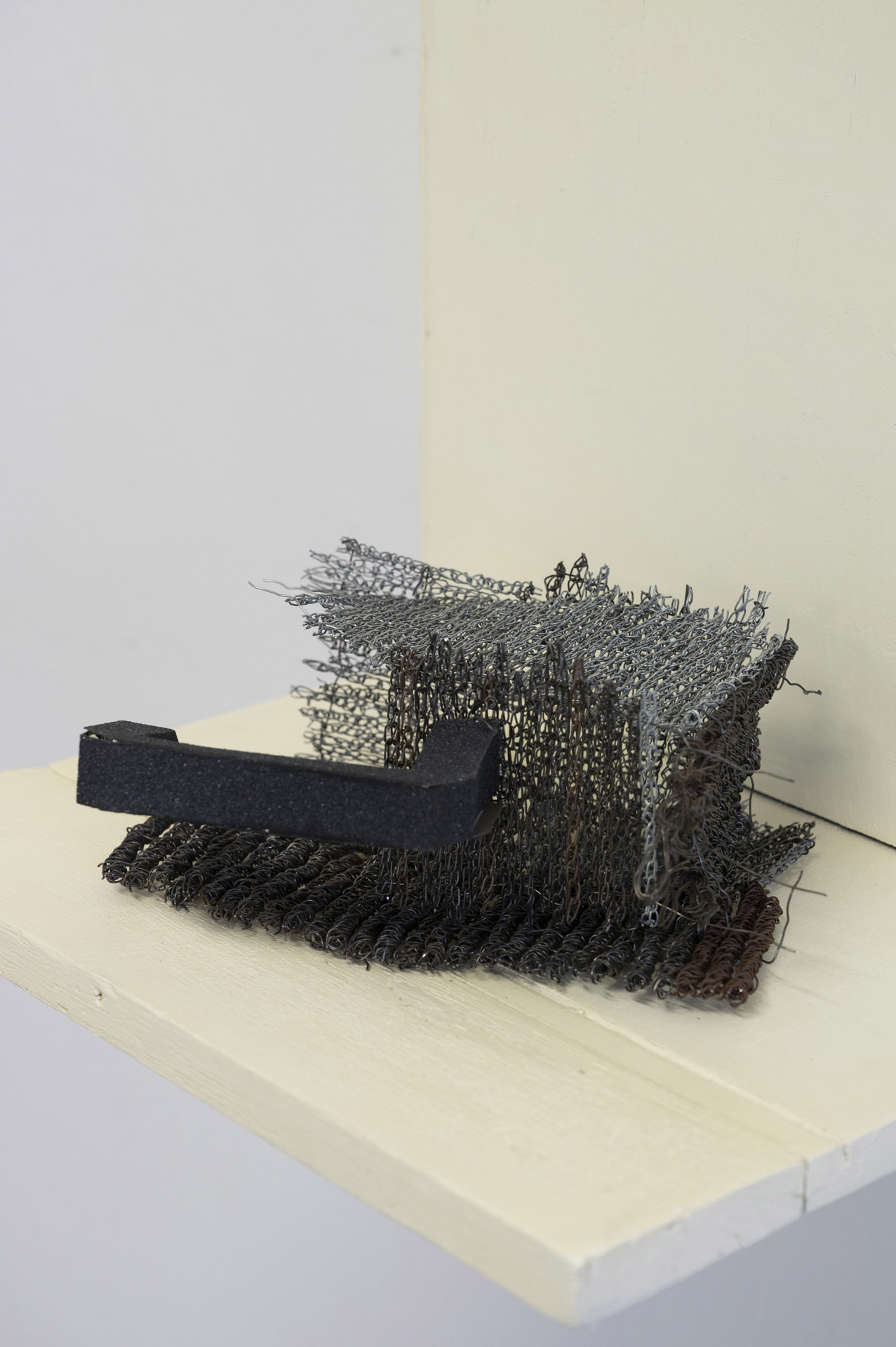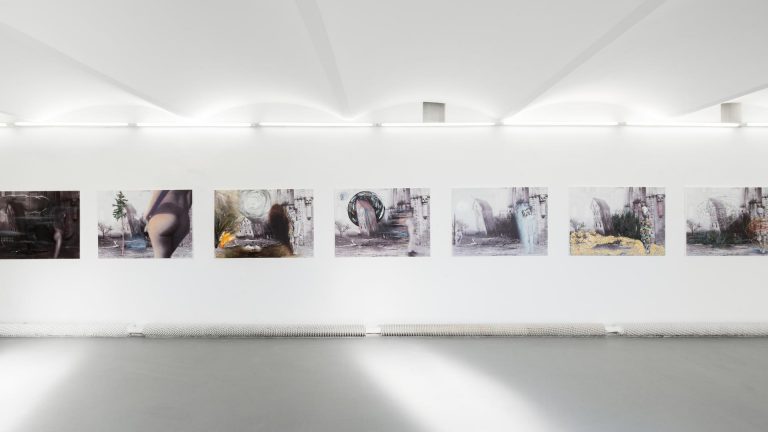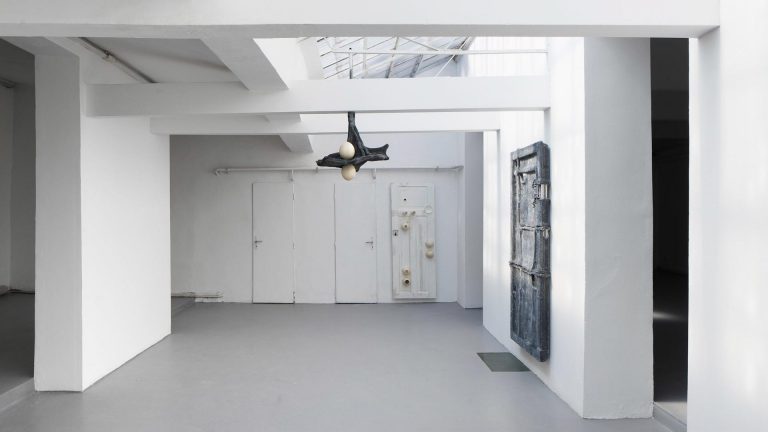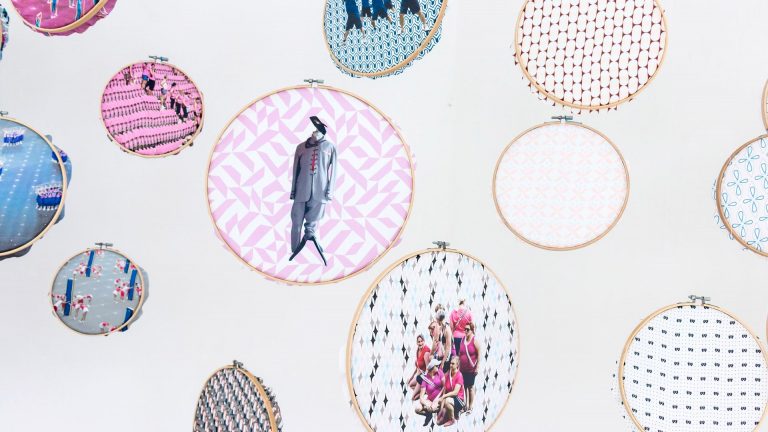Artists: Jakub Hájek & František Hanousek
Exhibition title: Carnival of the rabble: dissolved destinies
Curated by: Tereza Havlovicová & Ján Gajdušek
Venue: Holešovická Šachta, Prague, The Czech Republic
Date: July 26 – August 27, 2021
Photography: def image / all images copyright and courtesy of the artists and Holešovická Šachta, Prague
Rudolf is a mail carrier in the Lichtenberg district on the outskirts of Berlin. He is 28 years old, has an apprenticeship, a wife and three children, with whom he lives in a small house near the local post office. He gets up at 4.30 in the morning and cycles to work. He wears a tailor-made work uniform, which gives his profession an air of respectability. He takes pride in his work and is a member of a large trade union through which he has the chance, even at the lowest level, to participate in partial changes in the functioning and working conditions of his employer. His work week is divided into several blocks, between which he alternates between his duties as a personal delivery man in his neighbourhood and as an operator of the pneumatic pipeline mail network. The latter has only recently been set up and, using compressed air, is able to deliver correspondence and parcels almost immediately. It is also expanding the reach and efficiency of parcel delivery within the city and throughout the delivery system at an unprecedented rate. Rudolph is now covered by a social insurance program, a pension plan and, with luck, career advancement and a higher salary. He regularly returns from work at quarter to five and believes that one day one of his children could build on his success…
Berlin, August 1871.
Zbyšek works as a delivery driver for online delivery services in Prague. He is 28 years old, single, childless, has not finished university and lives in a shared apartment on the outskirts of Žižkov. He wakes up at five in the morning and, still in bed, spends a long time looking at the latest posts on his Facebook and Instagram. At six o’clock, he gets on his bike and puts a distinctive, foam-stuffed box with a large delivery service logo on his back. In the meantime, an order for a delivery from Vinohrady to Letná has popped up on his app. Within moments, he is loading the package and pedaling uphill to deliver it as quickly as possible. Zbyšek is a contractor, his employer is a large foreign start-up company that pays him for the minutes he drives and the number of orders he delivers. He does not have fixed working hours and his employer does not provide him with any social or other benefits. He is a means to perform a service, without the respect, without the gravitas of a postal uniform, just a box on his back. He comes home late, checks his mileage on the app and estimates his earnings for the day. He dreams of saving up and no longer having to deliver by bike, but by car…
Prague, August 2021.
When we take a closer look at the objects connected by pipes, we find that they can be perceived not only as repositories or boxes where the imaginary contents of the intricate piping system flow, but also as models, backdrops for buildings. Figuratively, then, they can act as branches of the delivery institution itself. This can be done both by using elements based on architecture and by using a certain scenographic element, e.g. in the form of fragments of a puppet evoking a postman or a postal clerk inhabiting a given “branch”. The mailboxes are connected to the pedestals, which, with their objects, merge into a broader structure, complementing each other, telling about each other. If we, as viewers, take on the visual metaphor of the delivery system and its individual parts, the scenic nature of the whole installation is heightened, and a glimpse into this closed world will be even more inviting in its scale to explore the details of the individual moments of the process unfolding on the “stage”. The authors of the exhibition, Jakub Hájek and František Hanousek, consciously work with content and formal contrasts, which they thoughtfully and with dark humour escalate to the point of absurdity.
The absurdity and irony in the works resonate strongly from the first reading. The authors were inspired by the rational system of the 19th century German postal system, or rather by a chapter in the book The Utopia of Rules by the recently deceased American anthropologist David Graeber, which discusses the technology and maturity of the German delivery system of the time and illuminates how closely this institution is intertwined, on a general level, with concepts of social and political systems (including their manipulative level) during the 19th century, with consequences that continue to the present day. The rationality and high-tech ethos of the German post office of the century before last is lost on the viewer in the exhibition, juxtaposed with the shabby tubes of the piped post office and the mailboxes themselves, their dirt, charred, neglected, amateurish cleaning. The seriousness of the original purpose is deliberately and ironically undermined by the chosen form. The question arises as to how the state delivery system is perceived by citizens at a time when its functions and services are increasingly being taken over by private companies. What does it say about today’s (advanced) society that in the 19th century the job of a postman had a serious sound, an aura of respectability, of which there is little left today?
In the system of installation that is presented to us, everything is connected into a single whole, and although it is logically built, we see that it is decaying, full of errors, perhaps caused by time, gradual wear and tear and obsolescence. The staff of the individual branches have tried to clean them up with their own inadequate efforts, to keep them running, to put the essentials in order and perhaps to make “their” environment more comfortable. The results of these efforts, however, only add to the impression of absurdity and futility. The penetration of chaos into the set rules of the originally functional system is mirrored in the drawing of knots on one of the boxes, in the flimsy wire walls that the authors of the exhibition gradually built out of their own intertwined wires, and in many other details of the artworks, including the way they were installed. The theme of the exhibited drawings is complemented by the motifs of the unstoppability of the (devilish) machine in motion, the suffocation of the environment, the tyranny and enslavement of the employees, the desire for career advancement through the various rungs of the ladder of the institutional hierarchy, etc. All this is presented by the authors in a very simplistic language full of funny abbreviations and chilling exaggerations.
Jakub Hájek (*1994) and František Hanousek (*1994) have been working as an artistic duo since 2017, when they completed their Bachelor’s degrees in New Media (Hanousek) and Multimedia (Hájek) at the Ladislav Sutnar Faculty of Design and Art at the University of West Bohemia in Pilsen. Since 2018, they have been continuing their Master’s studies at the Academy of Fine Arts in Prague in the Intermedia III studio under the supervision of Professor Tomáš Vaňek. They have completed residencies at the C. Rockefeller Center for Contemporary Arts in Dresden, the A.M. 180 gallery and the Dálava project at the Academy of Fine Arts in Prague. As part of collective exhibitions, they were part of the show Wasting Around: Tradition in Verses at the Bistro 21 gallery in Leipzig, and have exhibited at Futura Gallery, Meet Factory, City Surfer Office, Pragovka, and with the PGS collective.




